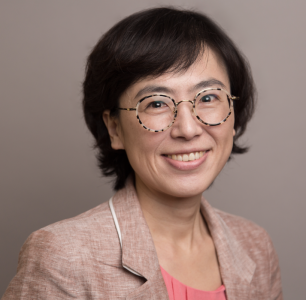Dr. Young-A Lee is an associate professor and Graduate Program Officer in Auburn’s Department of Consumer and Design Sciences. During her tenure, she has taught a wide variety of courses, as well as conducted a robust array of research and published numerous works. Her areas of focus include wearable technology and sustainable models of fashion, and she is interested in the opportunities available to the fashion industry to make sustainable, innovative clothing that meets the needs of both people and the planet.

Dr. Young-A Lee
It is evident from her current research that her passions and interests translate into her work. Presently, Dr. Lee is working on two major projects. The first is her research into personal protective equipment for healthcare workers, which is directly and indirectly related to COVID-19. This project includes ensuring that the donning and doffing process is as safe and efficient as possible. Donning and doffing–which is when healthcare workers put on and take off their equipment–is the point during their operations when healthcare workers are at greatest risk of infection. Though minimizing this risk is always important, her research takes on an elevated importance in light of our current global pandemic.
Dr. Lee’s other project that she is leading is with Alabama Cotton AwaREness (CARE), which is funded by Cotton Inc. CARE’s purpose is to facilitate awareness of cotton throughout its entire pipeline, as well as leveraging this knowledge to engender sustainable awareness and practices in Consumer and Design Sciences (CADS) students and beyond. Cotton, Lee says, is one of those few crops where nothing is wasted. Its byproducts are used to make fibers, cooking oil, and even utilized for 3-D printing materials. Though its use as a fiber is obviously the most relevant to CADS students, Lee believes that a holistic understanding of cotton’s lifespan helps students to turn towards sustainable mindsets. Once students understand how to analyze exactly how the fabrics that they work with get into their hands, they will be able to practice sustainable, cradle-to-cradle thinking that equips them to evaluate how to deepen their sustainable practices. “My main goal of sustainability and raising awareness is for my students to be fully aware of the entire pipeline…you [students] can reach out and learn about the growing process and why cotton is more sustainable and why we should use natural fibers over synthetic materials.” Lee stresses the significance of the cotton rotations that Auburn University itself has, saying that CADS students would benefit greatly from the opportunity to explore cotton rotations here in Auburn and in Alabama at large. “We need to think of how much awareness we do have, as an individual and as an apparel merchandising or design student, of the cotton that is growing in the state of Alabama, and what we do to take care of that cotton.” In the spirit of experiential learning, Lee developed the Upcycling Denim Design Challenge as part of CARE project, where CADS students are challenged to create innovative designs using recycled denim jeans. They are challenged to use as much of the used denim jeans as possible, including buttons and zippers. Lee says that this challenge has served to really make students think about how they can practically integrate sustainable practices into their future careers.
Sustainability has been an interest of Lee’s for quite some time. She describes this interest originating from her travel between South Korea and the U.S. during her undergraduate years and noticing how economic development was facilitated in developing countries. Lee explained how South Korea and Taiwan, at the time, used the apparel industry to bolster their economy, making wares for fast fashion industries that largely served the U.S. While she grants that it was good for these countries’ overall economy, Lee noted the negative repercussions it had on the environment and wellbeing of laborers. Water pollution, air pollution, and increased health risks for laborers are just a few of the issues she mentions, and they were all observations that led her to develop a significant interest in sustainability. One of her central concerns with fast fashion is the impact it leaves on countries who are producing garments for other countries who do not have to live with the footprint of their consumption. “I just thought about that in 1990, and now we see the side effects in all of those countries…and now it’s moving into China and into Vietnam and Sri Lanka and I just have to ask ‘what will be the next country polluting for us?’ But we are all wearing the clothing, not thinking about that.” To further her point, Lee mentioned the 2012 Dhaka garment factory fire in Bangladesh, which is the deadliest factory fire in world history. The factory’s lack of fire exits and safety precautions are attributed as a leading cause in the death toll of this fire, leaving serious implications for workers’ rights and safety. In light of the fact that this factory was producing apparel for American consumption, this incident needs to be brought into our national discussion of sustainability. To sum, Lee offers the question “Do we need to have these many clothes? Can we mitigate some of the negative impact for these countries, not just for their environment but for their people?”
Lee hopes to continue her work with educating students and conducting research with a holistic, cradle-to-cradle mindset. This work, to her, is fulfilling, and all about leveraging her skills and knowledge to create a more sustainable world. “I have to do little things to make little changes and raise awareness.”
Post Contributed by Chloe McMahon, Program Coordinator, Office of Sustainability




